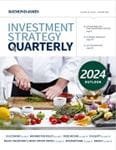Raymond James
Markets & Investing
January 02, 2024
As a new year begins, Raymond James CIO Larry Adam serves up his outlook on the financial markets.
To read the full article, see the Investment Strategy Quarterly publication linked below.
On Top Chef, one of America’s most popular kitchen competition television shows, contestants walk in with knowledge and experience – but no idea what challenges they are about to face. Their goal is to prepare a dish that pleases the expert chefs judging them, but the judges toss in a mix of ingredients that no contestant would expect. The aspiring chefs must think on their feet, improvise and beat the clock.
Sound familiar? Not only was fast footwork the investment story in 2023, the competition is set to get stiffer in 2024. Here are our 10 themes for 2024. Count on more than a few surprise ingredients throughout the year to spice up the financial markets.
1. U.S. economy: "Rotisserie" cycles
The most talked about recession in history has yet to materialize. Many economists have stopped waiting for the delivery and have revised the menu. We still believe that a recession will start in 2Q, but it will likely be the mildest ever. Indeed, it may be so mild that markets barely notice it. We expect the recession to be mild because there are no excesses in the economy, and like a rotisserie oven, many parts of the economy have been rotating from hot to cold independently over the last few years. Even with a mild recession, a recovery by year end should help U.S. GDP warm to a ~1% growth rate for the entire year.
2. Monetary policy: Chairman Powell, the top chef
The Federal Reserve (Fed) is led by our favorite Top Chef: Jerome Powell. Under pressure to cool inflation, he served up a steady course of interest rate hikes over the last 18 months and whipped inflation from 9% to 3.1% currently. Since that restrictive diet is done, the Fed will turn its attention to fattening the economy as growth concerns mount (i.e., a modest rise in unemployment and a potential recession). Markets are salivating over the possibility of as many as six interest rate cuts in 2024, but we believe that is overly optimistic; we favor three or four. More rate cuts than that would likely mean the economy is struggling more than we anticipate.
3. Fixed income: A makeover "rescue"
Like the guests on Bar Rescue, fixed income investors for the last few years may have felt like they were in bad shape, just like the shabby drinking establishments on the show. In both cases, the underlying business and fundamentals are in place and a makeover is all that’s needed. That makeover occurred in the bond market as the sharp reset to higher interest rates gave long-term investors an attractive entry point.
4. U.S. equities: The critical eye of Gordon Ramsay
In his show Hell’s Kitchen, Gordon Ramsay is often hyper critical of the contestants. Just as he has a discerning eye for cooking, investors will need to be more selective in 2024 with their sector, region, style, and market capitalization choices. That’s because a lot of the good news has already been priced into the market, including expectations for a soft landing, Fed rate cuts and easing inflation. Given our expectation for a mild recession, investors should turn a skeptical eye to a consensus earnings estimate of $245 (+12% EPS growth). We think that is likely too frothy. Our expectation is that earnings growth will be only 2% to $225 for 2024. History (i.e., election years, Fed easing cycle, etc.) suggests our less spicy expectations for the S&P 500 – to 4,850 by year end 2024 – make more sense.
5. Sectors: New ideas, richer flavors
With a slowing economic environment, earnings growth will be a decisive factor in determining sector performance. That’s why our 2024 ‘Michelin Star’ sectors are like America’s Test Kitchen: familiar spaces being improved by experimenting with new gadgets and ingredients.
6. Small-cap equities: Don't pass up the "dives"
On Diners, Drive-Ins and Dives, Guy Fieri fires up his bright red 1968 Chevy Camaro convertible and goes roaring around America to find great food in unexpected, small, relatively unknown places. While some ‘dive’ restaurants look ugly on the outside, the food and atmosphere on the inside make up for it. Underperforming small-cap equities may appear unappealing at first glance, but fundamentals under the surface make them worth visiting.
7. International equities: U.S. is "Grade A"
When looking at the global equity markets, U.S. equities are still our prime choice. Developed market international equities are ‘sale priced’ relative to U.S. equities, but growth headwinds could spoil earnings trends in the coming quarters, particularly in Europe. Japanese equities may be an outlier in 2024, underpinned by corporate governance reforms and an ongoing economic recovery. Emerging markets remain a long-term opportunity for investors. They should ripen with the end of the Fed tightening cycle, a modest weakening in the dollar and a rebound in economic growth in Asia and Latin America.
8. Energy: Discipline in the kitchen
Discipline is important when you’re wielding a sharp knife or cooking over an open flame. It’s even more important in the energy market. In 2023, OPEC+ was disciplined for controlling oil supply. And private companies – especially smaller ones – exercised careful capital discipline in drilling for additional oil. In general, we believe energy production discipline will continue to limit the growth of the oil supply.
9. Volatility: Turning up the heat
Volatility was relatively modest last year from a historical perspective. Why? Because of exceptional pessimism at the beginning of last year. Investors feared a recession, stubborn inflation, imploding corporate earnings and the Russia/Ukraine war. In retrospect, that pessimism was overstated; each of those dynamics had surprisingly more favorable outcomes – at least in the markets’ eyes. In 2024, we appear to have the opposite view: uber-optimism leaves the market vulnerable to disappointment. If you thought the kitchen was kind of warm last year, get ready for more volatility in 2024.
10. Asset allocation: Pace yourself at the buffet
We want investors to experience well-crafted fare, which is why we place so much attention on building an asset allocation that matches your tastes. We are factoring in a modest upside for most asset classes in 2024, but don’t let a so-called ‘everything rally’ distract you from maintaining a commitment to a well- structured asset allocation. Faced with a big buffet, it is tempting to splurge on whatever looks good today, ignoring a balanced, more healthy approach. Asset allocation strategies, for the most part, should be in place long term. They remind me of one of the most famous infomercial taglines of all time – the "Set and Forget It" rotisserie oven. "Set it and forget it" is great advice, particularly in challenging and more volatile markets. Timing is also important: decisive short- term moves can sometimes save a meal, but panic-driven actions can ruin it. That’s why, when it comes to a longer-term investment horizon, we prefer to let things marinate.
We look at the future like the mystery basket in Chopped – the ingredients inside could be anything. Creative chefs know how to work with what they are given. We encourage you to peek into our kitchen, with our updated views on what’s cooking, throughout the year. World-renowned chef Bobby Flay said: “Cooking is a subject you can never know enough about. There is always something new to discover.” Don’t let uncertainty scare you out of the market – turn to your sous-chef (AKA your financial advisor) – for support and guidance when things heat up.
All expressions of opinion reflect the judgment of the Chief Investment Office, and are subject to change. This information should not be construed as a recommendation. The foregoing content is subject to change at any time without notice. Content provided herein is for informational purposes only. There is no guarantee that these statements, opinions or forecasts provided herein will prove to be correct. Past performance may not be indicative of future results. Asset allocation and diversification do not guarantee a profit nor protect against loss. The S&P 500 is an unmanaged index of 500 widely held stocks that is generally considered representative of the U.S. stock market. Keep in mind that individuals cannot invest directly in any index, and index performance does not include transaction costs or other fees, which will affect actual investment performance. Individual investor’s results will vary. Investing in small cap stocks generally involves greater risks, and therefore, may not be appropriate for every investor. International investing involves special risks, including currency fluctuations, differing financial accounting standards, and possible political and economic volatility. Investing in emerging markets can be riskier than investing in well-established foreign markets. Investing in the energy sector involves special risks, including the potential adverse effects of state and federal regulation and may not be suitable for all investors.
There is an inverse relationship between interest rate movements and fixed income prices. Generally, when interest rates rise, fixed income prices fall and when interest rates fall, fixed income prices rise. If bonds are sold prior to maturity, the proceeds may be more or less than original cost. A credit rating of a security is not a recommendation to buy, sell or hold securities and may be subject to review, revisions, suspension, reduction or withdrawal at any time by the assigning rating agency. Investing in REITs can be subject to declines in the value of real estate. Economic conditions, property taxes, tax laws and interest rates all present potential risks to real estate investments. The companies engaged in business related to a specific sector are subject to fierce competition and their products and services may be subject to rapid obsolescence.
CFA® and Chartered Financial Analyst® are registered trademarks owned by CFA Institute.
Investments & Wealth Institute™ (The Institute) is the owner of the certification marks “CIMA” and “Certified Investment Management Analyst.” Use of CIMA and/or Certified Investment Management Analyst signifies that the user has successfully completed The Institute’s initial and ongoing credentialing requirements for investment management professionals.
Certified Financial Planner Board of Standards Inc. owns the certification marks CFP®, Certified Financial Planner™, CFP® (with plaque design) and CFP® (with flame design) in the U.S., which it awards to individuals who successfully complete CFP Board’s initial and ongoing certification requirements.

























